About the Production
Luisa, the daughter of the veteran Miller, is in love with a young hunter who has come to her village with the arrival of the new feudal lord. But Wurm, the castle steward, is also in love with Luisa. He reveals the true identity of the supposed huntsman to her father: It is Rodolfo, the feudal lord's son, which makes a marriage with Luisa impossible for reasons of status. Rodolfo wants to fight for his love, but he and Luisa fall into the trap of the intriguing and corrupt court society.
Verdi's abysmally brilliant, expressive and emotionally saturated music not only celebrates the devotion to great passions, but also makes the oppressive and repulsive disinhibition of their abysses tangible. Verdi was 36 years old when he premiered Luisa Miller in Naples in 1849. The opera was written shortly before the "popular triad" of Rigoletto, Troubadour and Traviata (1851-53). Due to the density of its musical inspiration, the opera is a fully-fledged work from Verdi's mature period, even anticipating the final image of Otello: both finales depict the jealous murder of a lover of his beloved, whom he believes to be unfaithful due to an intrigue.
From a German-speaking perspective, the radical nature of the opera is underestimated because people believe they can measure it against the original play, Schiller's bourgeois tragedy Kabale und Liebe (1784). In reality, the opera represents the culmination and end of the Italian semiseria tradition, which led love that transcended class boundaries to an always happy ending - despite painful blows of fate and misunderstandings. Here, the fragile love between the feudal lord's son and a soldier's daughter is shattered in the mills of power and marriage politics, intrigue and crime.



